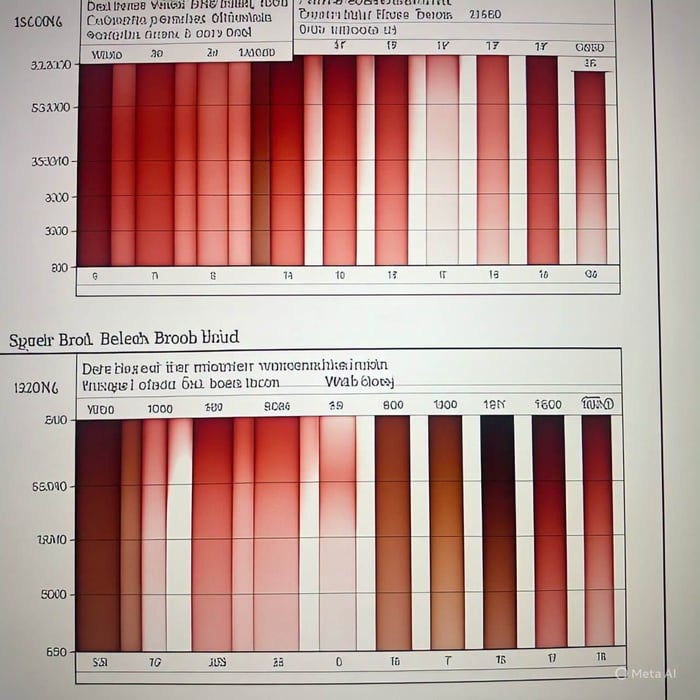Hunting isn't about simply pulling the trigger; it's about knowing the animal, the terrain, and the tracks left behind. One of the most important things any hunter needs to do is track a shot deer, and that's where the liver shot deer blood color chart comes into effect. This tutorial will take you through all that you should know concerning how to identify a liver shot, blood color interpretation, and applying all this to successfully track your deer.
Why the Liver Shot Deer Blood Color Chart Matters
When you shoot a deer, the nature of the shot you make determines the blood trail you will follow. A liver shot is one of the most frequent hits, particularly for bowhunters, since the liver is a large organ just behind the diaphragm. Having knowledge of reading the liver shot deer blood color chart can mean the difference between recovering your deer or losing it in the forest. The chart assists you in determining the color, consistency, and other indicators of the blood to verify if you've struck the liver and how to continue with the tracking.
Liver is an important organ, and a shot there will kill you, but it's not a quick kill such as a lung or heart shot. A deer that is shot in the liver will walk quite a distance before laying down, so it's important to know about the liver shot deer blood color chart for ethical hunting and recovering your game.
What Is a Liver Shot?
Before diving into the liver shot deer blood color chart, let’s talk about what a liver shot is. The liver is a large, dark organ that processes toxins and stores energy in a deer’s body. It’s located in the abdominal cavity, just behind the lungs and below the spine. When an arrow or bullet hits the liver, it causes significant internal bleeding, but the deer may not show immediate signs of distress.
A liver-shot deer could bolt off as if nothing happened to it, though the internal damage is extreme. The liver shot deer blood color chart aids you in verifying this type of hit by inspecting the blood trail. A liver shot usually results in dark, rich blood that differs from the light red of a lung shot or the bloody water of a muscle hit.
Unpacking the Liver Shot Deer Blood Color Chart
Liver shot deer blood color chart is a chart that hunters refer to in order to decipher the blood they discover when they shoot a deer. Blood color, consistency, and quantity can inform you so much about where the animal has been hit and how long it will take for it to die. This is what to expect when using the liver shot deer blood color chart.
Blood Color: Dark Red to Maroon
The distinguishing characteristic of a liver shot is dark red or maroon-colored blood. This color is a result of the liver's function in filtering blood and the fact that the liver is composed mostly of deoxygenated blood. If you notice this color on the ground or on leaves, it is a strong indication of a liver shot. The liver shot deer blood color chart places particular stress on this dark color as the best indicator.
As opposed to the bright, foamy blood of a lung shot or the pale red of a muscle hit, liver blood is dark and uniform. It can also be a bit thicker in consistency due to the clotting function of the liver. In tracking, reference the liver shot deer blood color chart to verify this color and not confuse it with other kinds of hits.
Blood Volume and Pattern
Liver shots generally yield a steady but moderate trail of blood. You won't experience the heavy spurts of a heart shot or the sprayed blood of an arterial hit. Instead, the liver shot deer blood color chart will have a consistent blood trail with little drops or smears a few feet apart. The volume and pattern can be determined by the liver shot deer blood color chart to ensure you're tracking in the right direction.
As the deer travels, the blood can decrease over time due to the liver's internal bleeding collecting in the abdominal cavity. That is why the liver shot deer blood color chart is so useful—it prepares you for a trail that may begin strongly but fade out, and which demands close attention to subtle signs such as scuffed leaves or snapped twigs.
Other Signs to Look For
Though the liver shot deer blood color chart is concerned with blood, there are other indicators that can establish a liver hit. For instance, a liver-shot deer can have a bile or greenish fluid trail behind it, which is from the liver or adjacent digestive organs. You may also see small fatty tissue or organ fragments, which are typical of abdominal shots.
Liver shot deer blood color chart makes you consider beyond blood. Observe the behavior of the deer following the shot. A liver-shot deer tends to hunch up its back, walk slowly, or bed down within 100-200 yards. The combination of the above behavioral cues along with the liver shot deer blood color chart tells you the full story of the hit.
How to Use the Liver Shot Deer Blood Color Chart in the Field
Having learned the fundamentals of the liver shot deer blood color chart, let's discuss how to use it in the field while tracking. Tracking a liver-shot deer is not easy; it needs patience, keen observation skills, and a systematic approach. Here's a step-by-step guide to using the liver shot deer blood color chart successfully.
Step 1: Mark the Shot Location
The moment you fire, tag the location where the deer is standing. This provides a point of reference for tracking. Examine the area for blood, hair, or arrow pieces present. If bowhunting, examine your arrow for blood color and refer to the liver shot deer blood color chart. A dark red color with a slightly oily texture is an indicator of a liver strike.
Step 2: Wait Before Tracking
Liver shots take time for the deer to die. In contrast to lung or heart shots, in which the deer can drop instantly, a liver-shot deer might take 1-2 hours to die. The liver shot deer blood color chart recommends waiting at least 30-60 minutes before pursuing to prevent further stressing the deer. Take the time to examine the liver shot deer blood color chart and ready yourself for the trail ahead.
Step 3: Tracking the Blood Trail
After initiating the track, proceed slowly and search for blood on the ground, foliage, or trees. Refer to the liver shot deer blood color chart to identify the dark red or maroon hue. In a sparse trail, crouch low to find minute drops or smears. Identify each blood smear with flagging tape to ensure you do not lose the track.
Step 4: Search for Bedding Sites
Liver-shot deer will bed several times as they succumb. Look for flattened grass, blood puddles, or disturbed ground. The liver shot deer blood color chart can aid you in recognizing blood at these locations, which will be thicker or darker from clotting. Approach a bedding site carefully because the deer could still be alive.
Step 5: Retrieve the Deer
With patience and careful follow-up, you will eventually locate your deer. Use the liver shot deer blood color chart to verify the hit when you inspect the animal. A liver-shot deer will have extensive internal bleeding in the abdominal cavity, with dark blood accumulated around the liver.
Common Mistakes When Using the Liver Shot Deer Blood Color Chart
Even with the liver shot deer blood color chart, errors can occur. Below are some of the common mistakes to avoid when tracking a liver-shot deer.
Mistaking Blood Color
One of the largest mistakes is interpreting blood color incorrectly. The bright red blood could be mistaken for the darker red of a liver shot, particularly in poor lighting. Always have a flashlight and consult the liver shot blood color chart to double confirm. In doubt, check for bile or organ tissue.
Tracking Too Soon
Patience is a hunter's best friend. Waiting too long to track a liver-shot deer can cause it to move further, and recovery will be more difficult. The liver shot blood color chart highlights the need to wait to allow the deer time to die. Follow the suggested waiting period of 1-2 hours.
Losing the Trail
Liver shot blood trails may be light, particularly if the deer passes through heavy cover. If you lose the trail, work back to the last known blood location and expand your search. The liver shot blood color chart reminds you to search for secondary signs such as tracks or torn vegetation.
Tips for Ethical Hunting with the Liver Shot Der Blood Color Chart
Ethical hunting is all about showing respect to the animal and making a clean, humane kill. The liver shot der blood color chart is a guide to assist you in doing that. Below are some tips on how to hunt ethically using the chart.
Practice Shot Placement
The best way to avoid a liver shot is to aim for the heart or lungs. Practice with your bow or rifle to improve accuracy. If you do land a liver shot, the liver shot der blood color chart will help you recover the deer, but prevention is always better.
Use Quality Equipment
A well-sharpened broadhead or high-powered rifle guarantees a clean shot and clearer blood trails. Low-quality equipment results in poor blood trails, making the liver shot der blood color chart more difficult to implement. Use quality gear to enhance your tracking success.
Respect the Animal
Each deer should have a swift, humane death. If you verify a liver shot by using the liver shot deer blood color chart, do your best to recover the animal. Leaving an injured deer in the woods is not only immoral but also a waste of a precious resource.
Comparing Liver Shots to Other Hits
To really grasp the liver shot deer blood color chart, it's helpful to consider liver shots relative to other shots. Here's how a liver shot compares with typical shot locations.
Lung Shot
A lung shot yields bright red, frothy blood from the oxygen-rich conditions of the lungs. The trail of blood tends to be heavy and easy to track. The liver shot der blood color chart differentiates this by pointing out the darker, non-frothy blood of a liver hit.
Heart Shot
Heart shots produce bright red blood with spurs that are heavy, since the heart forces the blood through quickly. The deer will usually fall within 50 yards. The liver shot der blood color chart establishes that the blood of a liver shot is darker and less abundant than heart shot blood.
Muscle Shot
A muscle shot yields pale red or watery blood with little quantity. The deer can live with a muscle hit, but not a liver shot. The liver shot blood color chart prevents you from confusing a muscle hit with a fatal liver shot.
Advanced Tips for Using the Liver Shot Blood Color Chart
For experienced hunters, the liver shot blood color chart can be part of a broader tracking strategy. Here are some advanced tips to take your skills to the next level.
Use Technology
Advanced trail cameras and GPS units can assist you in following a liver-shot deer. Place cameras around potential bedding spots and use GPS to note blood spots. The liver shot blood color chart is the accompaniment to these resources by verifying the hit type.
Learn Blood Trailing Patterns
Seasoned trackers understand that blood trails have a consistent pattern based on topography and deer activity. Learn to observe how blood pools in low spots or smears on up-slopes. The liver shot blood color chart provides you with the reference to decode these patterns.
Train with Mock Trails
Practice tracking by making dummy blood trails using red food coloring or animal blood. Compare your results to the liver shot blood color chart to sharpen your skills. This practical experience makes you more confident in the field.
Conclusion: Master the Liver Shot Deer Blood Color Chart
Stalking a wounded deer is an art and a science, and the liver shot blood color chart is your ticket to success. With knowledge of blood color, volume, and other indicators, you can safely track a liver-shot deer and recover your prize. Whether new to hunting or an experienced pro, the liver shot deer blood color chart is a must-have for ethical, effective hunting.
Take time to learn the liver shot blood color chart, hone your tracking skills, and be respectful of the animals you hunt. With time and knowledge, you'll be a finer hunter and make each shot count. Happy hunting!





